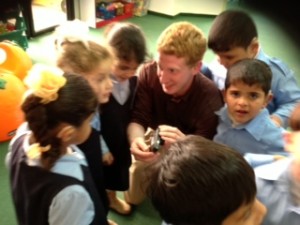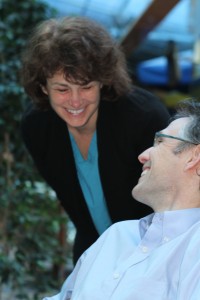Gazans dedication to families is clear even in orphanages, by Gerri Haynes
(Gerri Haynes, former president of Washington Physicians for Social Responsibility, has returned to Gaza with a delegation of doctors, nurses and others interested in helping the people there. Gerri will be sending back reports.)
Day five in Gaza
In the Al-amal Institute for Orphans and in the Atfaluna Society for Deaf Children the dedication of the people of Gaza to their families is clearly evident. The orphanage serves children from five years to eighteen years of age. Most children of Gaza whose parents have died are taken care of by their families – even when the families are extremely poor. Some of the 100 children in the orphanage are not fully orphaned – they may be without a mother or a father but come from a situation where the remaining parent is unable to provide a home. The parent may visit the child but the orphanage assumes 24-hour care for the child and mainstreams them into the neighborhood for school.The facility is impeccably clean and each child is
taught to be responsible for his or her living area. We met with the Director of the orphanage and gave him some of the school supplies donated in Seattle. With war a constant threat and too-frequent reality, the Director told us there are 5,000 – 7,000 orphans in Gaza, served by two facilities and many families.Alfaluna, the institute for the care of deaf children is another inspirational organization in Gaza.
David Helfand writes:
“As adults we learn to hide our fear. We use bravado, humor, silence, and any number of other mechanisms to mask the psychological and emotional scars left by the struggles and traumas in our lives. Children are not such good liars. As a stranger stepping into a kindergarten class at the Atfaluna Society for Deaf Children, one might expect to be greeted with apprehension or fear. However, what I found was the opposite. The boys and girls stepped forward with wide smiles, eager to shake hands with us, some of them repeatedly. They posed for photographs, and then crowded around, jostling and pushing up against us to see the results. These children live in a place where life is a constant struggle and terror can and has ruled the day. With hearing impairments they face further challenges beyond those of their peers. Some might argue that they do not show fear simply because they are too young to know better or to understand the world around them. There may certainly be some truth to this idea. There is no way that siege, bombardment, poverty, and repression could possibly leave these children unaffected. But the fact that even in such circumstances the most vulnerable members of society can show such enthusiasm and appetite for life speaks volumes about the resiliency of the people of Gaza and the human race as a whole.”
We also visited the Water Authority to learn how Gaza is addressing critical issues regarding their water. The 1.7 million people of Gaza presently live with a diminishing supply of water – water that is 90 – 95% polluted. Plans for desalination and sewage treatment plants are complicated by the siege. Essential building materials are not available.
There is now only one crossing from Israel to Gaza and importation of building materials is strictly controlled. See the UNRWA report “Gaza 2020: A Livable Place?” for a picture of the environmental and humanitarian crisis facing Gaza.
RSS feed for comments on this post. TrackBack URI

